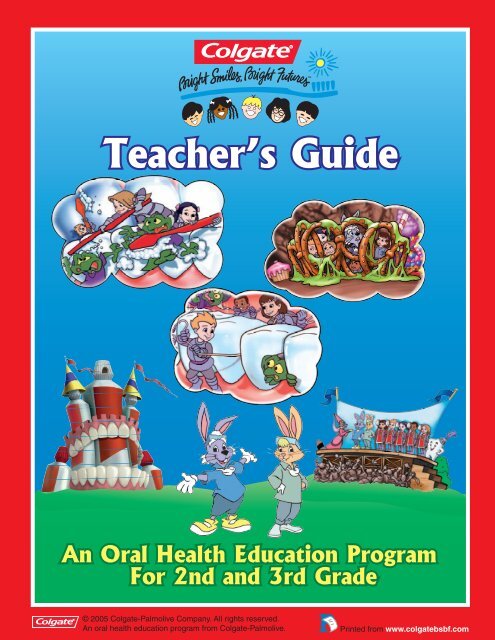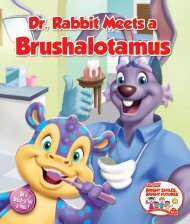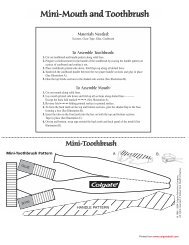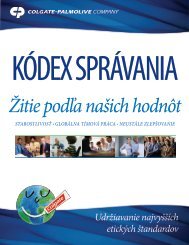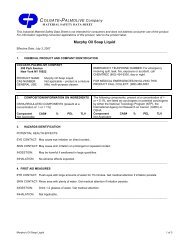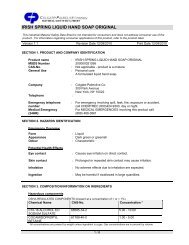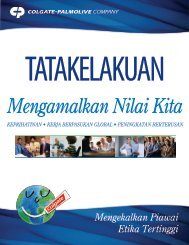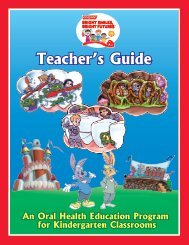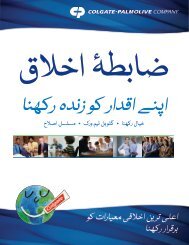TG GLO 2-3.qxd - Colgate
TG GLO 2-3.qxd - Colgate
TG GLO 2-3.qxd - Colgate
- No tags were found...
Create successful ePaper yourself
Turn your PDF publications into a flip-book with our unique Google optimized e-Paper software.
Scene 3Happy Smiles Supply RoomScene 4On the RoadScene 5Plaque Monster CaveScene 6At Sugar MountainThis warehouse of plaque-fighting tools has gianttoothbrushes, toothpaste tubes, and dental floss. Thekids are outfitted in official knights’ clothing, andmeet Roderick the donkey, who’ll be joining themon their journey. Paul has a bit of a problem keepinghis pants up – his knight costume is a little too big!Then, Dr. Rabbit shows the team his most secretweapon . . . a special lantern that glows to revealhidden plaque. Meanwhile, Sorcerer Plakula hasplans to set oral health obstacles along the way . . .As the new knights and the Royal Dentists head off ontheir journey . . . watch for the sneaky Plaque Monsters,who are busy hiding tempting, sweet, and starchy foodsalong the road.As they go along, Paul is still having troublekeeping his pants up. Meanwhile, Plaque Monsters aresneakily “planting” snacks along the route, tempting thechildren to eat too many snacks. The song ends andRoderick is tempted to have a snack – but Dr. Brushwellreminds him that he just had a snack, and shouldn’tsnack all the time!Oral Health Messages:The group comes upon a mysterious looking cave . . .• Brush all teeth, including thosethe rocks and boulders look like giant teeth. At first theyway in the back.think the cave is empty . . . but wait! A glow begins toshine from within the cart. It’s the magic lantern! •Brushing with fluorideDr. Rabbit pulls the magic lantern from its chest . . . strengthens teeth and keepsand before the knights’ eyes, Plaque Monsters are breath fresh.revealed to be hiding everywhere. Dr. Brushwell helps • Don’t forget to brush your tongue.the kids load up their brushes with fluoride toothpaste to • Replace your toothbrush when itbrush the Plaque Monsters away.becomes splayed, or “shaggy”The group does a great job brushing away almost all (every 3 months).of the Plaque Monsters . . . but there are a few that they•Never share your toothbrush.just can’t reach. Roderick helps the kids discover thatthey need to use dental floss to get the Plaque Monsters• Floss daily to remove plaque thatthat brushing missed! Dr. Brushwell reminds children brushing may have missed.about the proper way to floss. Then Robert discovers thata long length of floss is what Paul needs to hold his pants up!Our team arrives at Sugar Mountain. Dr. Brushwell andDr. Rabbit decide to take a look inside – and they tell thechildren to stay where they are. All seems normal . . .until a candy rope magically appears in front of Paul. Hepulls it, and a curtain of icing parts to reveal the IcingCaves! It’s a tempting place, filled with all kinds ofsweets and other snacks. There are even other childrenthere (but look closely, they are really Plaque Monstersin disguise!).Oral Health Messages:• Fluoride toothpaste, soft-bristledtoothbrushes, and dental floss arethe weapons with which to fightplaque.• Fluoride toothpaste not only keepsteeth strong and helps preventcavities – it keeps breath fresh, too!•Floss helps get rid of plaquebetween the teeth that brushingmay have missed.Oral Health Messages:• Snacking too often can causeplaque attacks. Fight plaqueattacks by limiting the numberof times you eat snacks each day.•You can get rid of plaque bybrushing teeth thoroughly withfluoride toothpaste at least twicea day.Oral Health Messages:• Snacking too often can causea plaque attack.• Plaque can attack all of yourteeth – including those way inthe back. Be sure to rememberto brush them, too!Robert and Paul start snacking on all kinds of treats! When Dr. Brushwell and Dr. Rabbitappear, the kids admit they’ve been snacking the whole time! “Quick!” exclaims Dr. Rabbit.“Everyone needs to brush!” But before they can get to the cart for supplies . . . the PlaqueMonsters leap from the boys’ mouths and begin to grow.5
ActivityJourney to Tooth KingdomCreating a Class DictionaryCurricular Connections: Language Arts(vocabulary, listening/comprehension, writing, storyelements of setting and plot) and Social StudiesActivity at a Glance:Students will watch the video in which five young kids embarkon an exciting journey to Tooth Kingdom where they learngood oral health habits. To prepare for this journey, thestudents create a class dictionary defining words related tooral health and Tooth Kingdom. After viewing the video, thestudents will create a story organizer to review their journey.Objectives:Oral health: The student will understand the meaning ofimportant oral health words (plaque, bacteria, cavities,floss, fluoride) and relate them to their own oral health.Curricular: The student will understand the meaning ofwords that are used in Dr. Rabbit and the Legend of ToothKingdom (sorcerer, lantern, squires, dungeon, catapult).Preparation:Materials: Dr. Rabbit and the Legend of Tooth Kingdom video, chart paper/chalkboard, crayons/paint/markers,colored paper, drawing paper, glue/tape, and materials tobind the class bookSet up: Ahead of time, draw a Beginning/Middle/Endstory organizer. (This is a 3 column chart used to organize,classify, or sequence events as they happen in the story.)This can be drawn on chart paper or the chalkboard.Introduction/Prior Knowledge:Ask students:• “Have you ever heard a storythat took place a long timeago?” (Discuss)• Tell students, “Today we aregoing to join Dr. Rabbit, Dr.Brushwell, and 5 kids on anexciting adventure to a land faraway in a time long ago.But first, let’s explore somewords that will help us alongour journey.”Procedures:• Introduce the oral health words (plaque,bacteria, cavities, floss, fluoride) andwords associated with Tooth Kingdom(sorcerer, lantern, squires, dungeon,catapult). Discuss and define words.• Divide students into groups. Assigneach group a word(s) to define byillustration. Each group will share theircreation with the class. Compile thewords and definitions into a class book.• Tell students that the words they definedwill be in the video.• Ask students, “What do you think theseoral health words have to do withsorcerers, dungeons, and lanterns?”Ask the students to share their ideas.• Now, ask students to picture their lastdental visit. “What if you were at thedental office and suddenly found yourselfin the middle of an exciting adventure?”Explain that the video begins in a dentistoffice and continues as the characterstravel back in time to a place called ToothKingdom. Then, watch the video.After the Video:Discuss the events of the video. Check for understanding.Suggested Questions:• What is the problem in Tooth Kingdom?• Did Paul and Robert make a good decision in choosing snacks?Why or why not?• What did the plaque monsters do? How does plaque damageour teeth? How did the children get rid of the plaque monsters?• Why did the Queen award the children?• Why do you think Dr. Rabbit and Dr. Brushwell shared thestory with the children? What did they learn from their trip toTooth Kingdom? What did you learn from the video?• Work together to complete a Beginning/Middle/Endstory organizer to check for understanding of themessages in the video. Guide students to reiterateevents in the video and discuss as a class under whichcolumn they belong.• For example, ask students, “What is one importantevent you remember from the video?” The childrenand dentists defeat Plakula. “Where would we list thisevent on our story organizer?” The end.• Write the events on the organizer. Students can alsoillustrate the events in pictures on the organizer.Application:• Using their story organizer, students willsummarize the video and the important oralhealth messages they learned.Closing:• Review the important oral health words and messages they learned.Extension:•Students can share their class book with a younger grade or family member.7
ActivityEscape from Sorcerer Plakula’s DungeonTeam Problem SolvingCurricular Connections: Problemsolving, decision making, cooperativeteamworkActivity at a Glance:In the video, the characters worked together to escapeSorcerer Plakula’s sticky traps. In this activity, thestudents will work together and use good problemsolving strategies to identify and discuss dilemmasand solutions related to oral health.Objectives:Oral Health: The student will identify proper oral health methodsand apply their oral health knowledge to problem solving.Curricular: The student will use good problem solving strategiesto solve dilemmas related to oral health and apply decision makingskills to their own lives.Preparation:Materials: Chart paper/chalkboard and crayons/markersSet-up: Draw a PMI Organizer. Divide the chart paper/chalkboard intothree categories. Label the categories: Plus, Minus, and Interesting.PMI OrganizerPlus Minus InterestingProcedures:Introduction/Prior Knowledge:• Ask students, “Can you recall a time you’ve had to makea hard decision about a problem you had? Is there alwaysone right solution to a problem?” Discuss how they’vehandled decisions in the past.• Ask students, “What obstacles did the children in the videoface? How did they handle these obstacles?” Make a list ofobstacles and how they handled each. Point out whichsolutions worked effectively and which did not.ExampleObstacle:• The children had to escape from the plaque dungeon bars.Solution:• They tried to squeeze through the bars. This did not work.• They tried to use the tooth soldiers, but the tooth soldierswere too weak.• Ask students, “How did they try to strengthen thetooth soldiers?” They used fluoride toothpaste.• Ask students, “But what about not reaching thefluoride toothpaste?” It was in the cart and the cartwas too far away. “How could they reach the cart?”They took the floss from Paul’s pants and made alasso to pull the cart closer.• Ask students, “How did they reach the tooth soldiersto strengthen them?” They made an extra longtoothbrush.• Ask students, “How did they get through the plaquedungeon bars?” They brushed the tooth soldiers withfluoride toothpaste and the tooth soldiers werestronger and saved the children.• Divide students into groups to re-enact the escapeusing props (created by the students) to simulate oralhealth tools.Application:• As a class, discuss other variables to the problem and how they can behandled. Ask students, “What if the extra long toothbrush broke? Whatother solutions might they try?” Make a class list of possible solutions.•Introduce the PMI problem solving strategy. For each solution, askstudents what is the plus, minus, and interesting parts of each solution andrecord their responses on the PMI Organizer. Students can discuss theseorally or write them down in chart form.• Ask students, “What do you think would be the best solution to the brokentoothbrush dilemma?” They should judge the plus, minus, and interestingpoints they came up with for possible solutions and then decide.Closing:• In their journal, ask students to selecttheir choice for the best solution and theplus, minus, and interesting points theycame up with. Students should justifytheir choice. Ask volunteers to share theirresponses.Extension:• Think of other variables or dilemmas thestudents could face. Think of alternativesolutions.8
ActivityTooth Team ChallengeOral Health GameCurricular Connections:Language Arts (comprehensionand writing)Activity at a Glance:Your students will take the Tooth Team Challenge andearn their knighthood by putting their knowledge of oralhealth to the test. In teams, students will answer cluesabout oral health and write their own clues to include inthe Tooth Team Challenge.Objectives:Oral Health: The student will recall oral health conceptspresented in the video.Curricular: The student will compose questions and identifyanswers to clues relating to oral health.Materials: Dr. Rabbit and the Legend of Tooth Kingdom video, scissors, clue cards, and paper/pencil for each teamPreparation:Teaching Tip: Create nametags for each team member to identify their role.Set-up: Photcopy and distribute one clue card sheet foreach team. (The Clue Master will cut the cards apart.)Introduction/Prior Knowledge:• Ask students, “What is your favoritegame or TV game show? Why?”• Tell students, “Today we are goingto play an exciting new gamecalled Tooth Team Challenge.”• Tell students “Just as the 5children in the video were knightsand fought Plakula and the plaquemonsters, you will earn yourknighthood by winning the ToothTeam Challenge. You will bedivided into teams of 5. Each ofyou will be given a role.TheSquire that has the most pointsat the end of the game will earnhis knighthood.”Identify the Roles:3 Squires: The ContestantsClue Master: Read clues for thesquires to answer.Score Sorcerer: Keep score ofthe game.Procedures:• Replay the finale song in the video. Encourage students to sing along.• Divide the class into teams and review the game rules for Tooth Team Challenge.Teaching Tip: Play the game a couple of times and let students change roles.Before the challenge begins, the ScoreSorcerer will write each Squire’s nameon a piece of paper in order to keep score.1. The Clue Master will read one ofthe clues.2. The first Squire to raise his/her hand willanswer the clue. The Score Sorcerer willobserve and ask the Squire who raiseshis/her hand first to answer the clue.3. The Squire must provide the answer in a“who” or “what” question format.For example, the clue would read,“I am the person who helps you in thelibrary.” The answer would be, “Who isthe librarian?”4. Each clue answered correctly and in theform of a question will receive a point.The Score Sorcerer will record the score.Game Rules5. If the first Squire does not answer theclue correctly or put his/her answer in aform of a question, then the Squire thatraised his hand second will have thechance to answer.6. Ties: If all the Squires raise their handsat the same time then the Score Sorcererwill pick a number 1 – 10 and the Squirethat guesses or comes closest to thatnumber answers the clue. If answeredincorrectly, the Score Sorcerer willrepeat for the other two Squires.7. Once the Clue Master has finished thestack of clue cards. The Squire that hasthe most points will earn his knighthood.If there is a tie, then both Squires earntheir knighthood.Application:•Students will work in teams to write their own clue cardsabout dental health. Have the teams play another round ofthe Tooth Team Challenge using their clue cards.Closing:• Review any clues they miss to ensure properunderstanding.9
You need to limit thesein order to reduce plaqueattacks.What are sweetand starchy snacks?This can weaken teeth.What is plaque?It causes a plaque attack.What is snackingtoo much?This is created whenbacteria comes into contactwith sweet or starchy foods.What is acid?This person is yourpartner in oral health.Do this once a day andhave your mom or dadhelp.If you do this at leasttwice a day, your smilewill shine.Taking control ofyour oral health.You have a splayedor shaggy toothbrush.This makes your teethstrong.What is fluoride?You should do this afterbreakfast and beforebedtime.Gets rid of plaque betweenthe teeth that brushing mayhave missed.Use this while brushingto remove plaque.Sticky stuff causedby bacteria in yourmouth.What is plaque?What is fluoridetoothpaste?What is floss?What is brushyour teeth?What is time to get anew toothbrush?How can you fightplaque?What is brush your teeth?What is floss?Who is a dentist ordental hygienist?Three weapons used tofight plaque.In addition to brushingyour teeth, you shouldalso brush this.What is your tongue?What is fluoride toothpaste,soft-bristled toothbrushes,and dental floss?
ActivityTooth Kingdom “By the Numbers”Math JournalCurricular Connections:Language Arts (writing,comprehension) and MathActivity at a Glance:Incorporate math into the adventures of Tooth Kingdom! Intrigue studentsby showing them how you can create math word problems with charactersand oral health messages from the video. The students will solve mathword problems using different strategies and create their own math wordproblems to spread the oral health messages.Teaching Tip: Have students use crayons to note clue words in the problems they solve.Provide hands-on manipulatives and counters for students struggling with fact computation.Preparation:Objectives:Oral Health: The student will identify oralhealth messages through solving math wordproblems.Curricular: The student will design and solvemath word problems using different problemMaterials: Chart paper/chalkboard, crayons, paper,pencil, clue words, and problem solving strategies.Set up: Post and review clue words (i.e., in all, how manymore, etc.) and problem solving strategies in the room (drawa picture, make a graph or table, etc.).Procedures:Introduction/Prior Knowledge:• Ask students, “How do you use math in your life every day?”Sample Math Problems1. Paul brushes at least 2 times a day each day of the week.How many times did he brush altogether in August? (PossibleStrategies: Make a table, count by 2s, use a calendar)2. Sarah brushed her teeth 2 times a day for one week. The nextweek, she forgot to brush after breakfast and only brushed onetime a day. What is the difference in the number of times shebrushed over the 2 weeks? (Possible Strategies: Make a table,use a calendar, subtraction)3. To fight plaque attacks, you should limit the number of times youeat snacks each day. For the first week, Robert ate 6 snacks perday. But realizing he needed to limit the number of snacks he ate,the second week, he ate 3 snacks per day. The third week he ate 2snacks per day. What is the difference between the number ofsnacks he ate the 1st and 2nd week? The 2nd and 3rd week? The1st and 3rd week? (Possible Strategies: Make a table, subtraction)• Present word problems to the class (see SampleMath Problems below). Work each problemtogether, highlighting clue words and discussingdifferent solution strategies.• Share their answers and solution strategies to eachproblem. Discuss any alternate strategies they mighthave used.4. Dr. Brushwell noticed your class’s toothbrusheswere shaggy and it was time to replace them. If 10toothbrushes come in a box, how many boxes willshe need to give your class so that each student hasa new toothbrush? (Possible Strategies: Make atable, multiplication, addition)5. Because fluoride toothpaste, soft-bristledtoothbrushes, and floss are the weapons withwhich to fight plaque, Dr. Rabbit wants to giveeach student in your class all 3 items to keephis/her teeth healthy. How many items will heneed to send so each student receives fluoridetoothpaste, soft-bristled toothbrushes, and floss?(Possible Strategies: Make a table, addition,multiplication)Application:• In groups, have students write their own oral health word problem.Then, exchange and solve word problems with another group.Closing:• Allow time for each group to share theirproblem-solving strategies.11
ActivityStop the Plaque AttackScience ExperimentCurricular Connections:Language Arts (writing)and ScienceActivities at a Glance:Your class can stop the plaque attacks by investigating how usingfluoride toothpaste significantly reduces the risk of cavities. Byconducting a hands-on experiment students will observe, recordresults, and draw conclusions on the effects of fluoride on teethand apply their conclusions to their oral health habits.Objectives:Oral health: The student will identify how fluoridestrengthens teeth and protects teeth from damageagainst plaque and acid.Curricular: The student will recognize scientificinvestigation by testing a hypothesis, collecting data,and analyzing results.Teaching Tips: Divide students into groups and assign roles (leader, recorder, measurer, etc.). Crete a poster that shows theresponsibilities of each role.Materials:• For each group: Lab sheet, 2 sport water bottles,2 balloons, black marker, and measuring tablespoon•To be shared: vinegar, box of non-coated colored chalk, and<strong>Colgate</strong> fluoride toothpaste (Note: The chalk must beNON-COATED for the experiment to work properly.)Preparation:Set up:Procedures:• Gather the materials, label what each represents(vinegar: acid from food, chalk: teeth, black spoton the balloon: cavity), and photocopy anddistribute at least one lab sheet for each group.Introduction/Prior Knowledge:•Ask students, “Have any ofyou ever seen a bike, a nail ora tool left out in the rain and itrusted?” Discuss any experiencesstudents may have hadwith any corrosive element. Ifavailable, provide real-lifeexamples of these.• Ask students “How do youthink food and sugar react withenamel on our teeth.” Foodslike sugars and starches reactwith the bacteria in our mouthsto create acid. This acidattacks our teeth and cancause cavities.• Review the lab sheet students will complete. Go over each section together.I. Title: Stop the Plaque Attack!II. Problem: (Discuss the problem you are investigating.): What effect doesfluoride have on teeth?III. Hypothesis: Define hypothesis. Discuss a hypothesis for this experiment.IV. Materials: Review listed materials. Explain that the vinegar represents acidfrom food, and chalk represents our teeth.V. Procedures: Review listed procedures.VI. Results: (What did you see, hear, or smell?) Students will record theirobservation in words and pictures.Note: The bottle with vinegar and chalk should show a large amount of gas causingthe balloon to expand. The bottle with vinegar, chalk, and toothpaste should alsoproduce gas, but significantly less so that the balloon does not inflate as much as itdid with the other bottle. The fluoride in <strong>Colgate</strong> toothpaste helps prevent theballoon from inflating just as the <strong>Colgate</strong> toothpaste helps prevent the formation ofcavities on our teeth.VII. Conclusions: Discuss what happened and possible conclusions students comeup with. The students should write 2-3 sentences describing their conclusions.Application:•Using their results and conclusions from theexperiment, have the students create a graphor chart comparing the sizes of balloons. Askthem to explain their graph or chart and howthe investigation relates to them personally.Closing:• Review how food causes acid on our teeth and fluoride toothpaste helpsprevent cavities. Discuss why we should use fluoride toothpaste.Extension:• Replicate the investigation for another class. Explain what you learned.12
Name(s):Stop thePLAQUE ATTACK!Lab SheetProblem (What question are you investigating?):Hypothesis (What do you think will happen?):Materials:•2 sport water bottles• box of NON-COATED,colored chalk•2 balloons• vinegar• black marker• <strong>Colgate</strong> fluoride toothpaste• measuring tablespoonProcedures:1. Label one water bottle with the word “fluoride.”2. Fill both water bottles half full with vinegar.3. Add 1 tablespoon of <strong>Colgate</strong> toothpaste to the water bottle labeled“fluoride.” Let it dissolve.4. Break a piece of chalk in half and put a piece into each bottle.5. Put the lid on each bottle and shake both bottles.6. Open the top of the bottle with fluoride toothpaste and place a balloonsnuggly over the top of the bottle. Open the top of the second bottle andplace the remaining balloon snuggly over the top of that bottle.Results: (What did you see, hear, or smell?) Record your observation in words and pictures.Conclusions: Discuss what happened and possible conclusions. Write 2 to 3 sentences explainingyour conclusion.* Using your results, turn the lab sheet over and create a graph or chart to compare the balloons.Write 4 to 5 sentences explaining the graph or chart.© 2004 <strong>Colgate</strong>-Palmolive Company. All rights reserved. A Global Oral Health Initiative.
ActivityDr. Rabbit’s Plaque CatcherOrigami GameCurricular Connections:Language Arts (comprehension,following directions)Activities at a Glance:Students will assist Dr. Rabbit in catching and gettingrid of plaque by applying oral health knowledge. Thestudent will create and design a Plaque Catcher withtheir own oral health questions and answers.Objectives:Oral Health: The student will identify four key oral health messages.Curricular: Students will apply their comprehension and writingskills by creating a Plaque Catcher that will employ their oral healthknowledge.Preparation:Materials: Plaque Catcher, Blank Plaque Catcher,and scissorsSet up: Prepare a Plaque Catcher ahead of time to show studentsthe finished product. Photocopy and distribute One PlaqueCatcher and one Blank Plaque Catcher per student.Procedures:Introduction/Prior Knowledge:• Show a completed PlaqueCatcher to the class. Askstudents, “Have you everseen one of these? What didyou use it for?” Discuss othergames they’ve played withsimilar objects.• Using next page, review the step-by-step instructions and guide the students tomake the Plaque Catcher. To model the steps, you may want to make one withthe students. Monitor student progress before continuing to the next step.• When the class is finished assembling their Plaque Catchers, demonstrate how tomake your thumbs and index fingers meet to open and close the plaque catcher.• Describe the game rules. Model it with a student.Game Rules:1. One player picks one of the printed squares while the other holds the plaquecatcher on his or her fingers.2. Open and close the plaque catcher in alternating directions while spelling outthe letters of the word on the printed square the player chose in step 1.3. Ask the question closest to the printed square chosen and let the other playeranswer.4. Look under the flap to find the correct answer.5. Switch with the other player. It’s his/her turn to answer.6. Alternate turns with the plaque catcher until all the questions are answered.• Allow time for students to pair up and play with the Plaque Catcher. Monitorteams to address any confusion with the directions.Application:• Using next page, have students make their own Plaque Catcher.Review the directions as the students follow along.• Each student should write an oral health phrase or related word inthe 4 outer corners. A question should be written on each triangletouching the outer corner. The answer to the question should go inthe triangle that touches the question.• Go through each step with them and let them fill in each space, oneat a time.Teaching Tip: You may want to make an overhead transparency orposter of the blank Plaque Catcher and color code each section tohelp students determine what and where to write.Closing:• Have students pair up and play with thePlaque Catchers they created. Share questionsand answers they came up with.Extension:•Take the Plaque Catchers home to play withfamily members or friends.14
Folding Instructions:Plaque Catcher1. Cut along the dotted lines.2. Place the Plaque Catcher facedown. Fold 2 corners together to form a triangle.Crease and unfold. Now fold the other 2 corners together, crease and unfold.3. Now, fold each corner to the center point.4. Turn the folded paper over and fold each corner into the center.5. Fold the square in half. Unfold it and fold it in half the other way.6. Using both hands, place your thumbs and index fingers under the flaps.What mineralin toothpastemakes yourteethstrong?What do “AfterBreakfast” and“Before Bedtime”have incommon?They both remindyou of when tobrush your teeth!Use dental floss.FlossHow can you getrid of plaquethat brushingmay havemissed?The letter “C”!What alphabetletter tells youhow to holddental flossagainst yourtooth?Fluoride.The X-ray machine.To prevent plaqueacid from attackingyour teeth.Why is it good tolimit the numberof times youeat snacks?What machinehelps the dentisttake pictures ofyour teeth?Who should youvisit regularlyto get yourteethchecked?The dentist.Sugars and starches.What two “S”words do PlaqueMonsters love?© 2004 <strong>Colgate</strong>-Palmolive Company. All rights reserved. A Global Oral Health Initiative.
Plaque Catcher (Blank)Folding Instructions:1. Cut along the dotted lines.2. Place the Plaque Catcher facedown. Fold 2 corners together to form a triangle.Crease and unfold. Now fold the other 2 corners together, crease and unfold.3. Now, fold each corner to the center point.4. Turn the folded paper over and fold each corner into the center.5. Fold the square in half. Unfold it and fold it in half the other way.6. Using both hands, place your thumbs and index fingers under the flaps.© 2004 <strong>Colgate</strong>-Palmolive Company. All rights reserved. A Global Oral Health Initiative.
ActivityBe a Brushing LegendMaking a 3-D Mouth ModelCurricular Connections:Language Arts (comprehension,following directions)Activity at a Glance:Challenge your students to become a Brushing Legend andmake brushing fun. In this activity, students will create aMini-Mouth and Toothbrush to practice proper brushingtechnique.Objectives:Oral Health: The student will demonstrate the properbrushing technique.Curricular: The student will create a model, demonstrateproper brushing technique, and employ writing skills tocreate their own questions and answers.Preparation:Materials: Mini-Mouth and Toothbrushsheet, clear tape/glue, scissors, cardboard,and 2-sided posterSet up: Photocopy and distribute one Mini-mouth and Toothbrush sheetper student. Prepare a model mouth and toothbrush ahead of time toshow students the final product.Introduction/Prior Knowledge:•Ask students, “Have you ever seenthe big model mouth and toothbrushthe dentist has in his/her office?Did the dentist show you the modelto help you learn how to brush yourteeth?” If possible, show thestudents a real-life model of themouth and toothbrush. Tell them,“Today we will make a modelmouth and toothbrush, too.”•Review the step-by-stepinstructions and guide studentsto create the model mouth andtoothbrush. Make a model alongwith the students. Walk aroundthe room and monitor students’progress.Procedures:Instructions:To Assemble Toothbrush:1. Cut out toothbrush and handlepattern along solid lines.2. Prepare a reinforcement for thehandle of the toothbrush bytracing the handle pattern on apiece of cardboard and cuttingit out.3. Place toothbrush printed sidedown. Fold flaps up along alldotted lines.4. Sandwich the cardboard handlebetween the two paper handlesections and glue in place(See Illustration A).5. Glue the top bristle sections to theshaded side section(See Illustration B).To Assemble Mouth:1. Cut out mouth along solid lines.2. Lay mouth printed side down and fold upall sections along dotted lines - - - - -Except the back fold marked • • • • • •(See Illustration A).3. Reverse fold • • • • • • folding printedsurface to printed surface.4. To form the back teeth on the top andbottom sections, glue the shaded flapto the base forming a box(See Illustration B).5. Insert the tabs on the front teeth into thebox on both the top and bottom sections.Tape in place (See Illustration C).6. On top and bottom, wrap tape around theback teeth and back panel of the model(See Illustration D).• When the class is finished assembling the Mini-Mouth and Toothbrush, usethe poster and demonstrate the proper brushing technique with students.• Give students time to practice the proper brushing technique with theirmodel mouth and toothbrush.Application:• In groups, challenge students to write a catchy phrase,acronym, or jingle to use to remember the properbrushing technique.Closing:• Share groups’ responses.Extension:• In groups, have students create a 3-panel brochure, poster,or song to teach others the proper brushing technique.17
Mini-Mouth and ToothbrushMaterials Needed:Scissors, Clear Tape, Glue, CardboardTo Assemble Toothbrush:1. Cut out toothbrush and handle pattern along solid lines.2. Prepare a reinforcement for the handle of the toothbrush by tracing the handle pattern ona piece of cardboard and cutting it out.3. Place toothbrush printed side down. Fold flaps up along all dotted lines.4. Sandwich the cardboard handle between the two paper handle sections and glue in place(See Illustration A).5. Glue the top bristle sections to the shaded side section (See Illustration B).To Assemble Mouth:1. Cut out mouth along solid lines.2. Lay mouth printed side down and fold up all sections along dotted lines ----------Except the back fold marked • • • • • •. (See Illustration A).3. Reverse fold • • • • • • folding printed surface to printed surface.4. To form the back teeth on the top and bottom sections, glue the shaded flap to the baseforming a box (See Illustration B).5. Insert the tabs on the front teeth into the box on both the top and bottom sections.Tape in place (See Illustration C).6. On top and bottom, wrap tape around the back teeth and back panel of the model (SeeIllustration D).Mini-ToothbrushMini-Toothbrush PatternA. B.GLUEGLUEHANDLE PATTERN© 1996 - 2004 <strong>Colgate</strong>-Palmolive Company.All rights reserved. A Global Oral Health Initiative.
A. B.Mini-MouthC. D.clear tapeclear tapeclear tapeBottomGLUEGLUEGLUEGLUE© 1996 - 2004 <strong>Colgate</strong>-Palmolive Company. All rights reserved. A Global Oral Health Initiative.
ActivityDr. Brushwell’s Brushing ChartGraphing ResultCurricular Connection:Math (graphing, interpretingcharts and tables)Activity at a Glance:Help your class and their families get into the habit ofbrushing their teeth at least twice a day. Students will useDr. Brushwell’s Brushing Chart to record brushing habitsfor themselves and their families over a month. Thestudents will then organize their data in a bar graph.Objectives:Oral Health: The student will record brushing habits for amonth and demonstrate responsibility for personal oral health.Curricular: The student will create a chart of brushing habitsand a bar graph of how many times he/she and his/her familymembers brush in a month.Preparation:Materials: Graph paper, colored pencils/crayons,Dr. Brushwell’s Brushing Chart, and samples of bargraphs for display.Set up: Photocopy and distribute one Brushing Chart perstudent. Complete a chart of your (teacher’s) brushinghabits to show the class.Teaching Tip:• Enlist help from the adults in the home by newsletter or note. Suggest they post the chart in the bathroomor other significant place to remind children to check off each time they brush.Introduction/Prior Knowledge:• Ask students, “How do youremember to brush your teeth?What reminds you to do this?”Discuss ways studentsremember to brush their teeth.For example, they may brushtheir teeth after putting on theirpajamas each night or after theyget up from the breakfast table.Procedures:1. Review the chart with students. “Starting this week, we will chart how often webrush our teeth each day and how often other family members brush.”2. Guide students to fill in their name and start date at the top of the sheet andcompletion date at the end of the chart (one month from the start date). Tellstudents, “Bring back this chart in one month on (date). Then we will graph theinformation you gathered.”3. Tell students, “Choose a color to use to chart your brushing and a differentcolor for each family member. Write your name and family members’ nameson the chart by the colors you chose.4. Explain that they will place a check on the chart for each time they brush. Thechecks will be the same color as their name. Have them place the first check ifthey brushed this morning.5. Students will take the chart home to complete.Application:• After returning their completed charts, students will use the datagathered and create a bar graph. Review what a bar graph looks like,showing examples of ones they’ve seen or used in class before.• Share the chart you (the teacher) completed about your own brushinghabits. Together create a bar graph using your chart. Point out how tolabel the vertical axis, horizontal axis, and how to draw the bars.• Guide students to create their bar graphs.Teaching Tip:• For students who did not get participation at home, have them comparetheir brushing with your (teacher’s) brushing on the graphing activity.Closing:• Ask volunteers to share their bar graphs.• Review why it is important to brush at leasttwice a day with fluoride toothpaste. Shareways students can help themselves rememberto brush at least twice a day.Extension:• Using the same data, create other types ofgraphs or tables using the same data (ex: linegraphs, pie graphs, etc.).20
“I am Dr. Brushwell – and this is mybrushing chart! It will help you rememberto brush your teeth with fluoride toothpasteat least twice a day, especially after eatingbreakfast and before bedtime.”Choose a crayon or colored pencil color to use on the chart. Choosea different color for each family member who may be brushing with you.Each of you should check off ( ) each time you brush, morning and night!© 2004 <strong>Colgate</strong>-Palmolive Company. All rights reserved. A Global Oral Health Initiative.
ActivityPop-Up Dental Appreciation CardsWriting a Thank YouCurricular Connection:Language Arts (writing)Activity at a Glance:Your students will give their appreciation for their dentist,their family, or other adults who have helped them havehealthy smiles and who have influenced good dental healthhabits. In this activity, students will review the format for afriendly letter and write thank you notes to the person thathas helped them earn their healthy smile.Objectives:Oral Health: The student will identify oral health messages,such as visiting the dentist and brushing regularly.Curricular: The student will identify parts of a thank youletter and compose thank you notes to dentists and otheradults who promote good dental health.Preparation:Materials: Pop-up Card and art materials(markers, crayons, colored pencils, envelopes)Set up: Photocopy and distribute one Pop-up Card perstudent. Disseminate art materials ahead of time. Displayexamples of thank you notes around the room.Introduction/Prior Knowledge:• Ask students, “What are someways we can let others knowwe appreciate somethingthey’ve done for us?” Saythank you, give them a gift, orreturn the favor and help them.• Share with student examplesof thank you notes.Procedures:• Review the format of a friendly letter (date, greeting, body, closing, signature).Have each student get out a piece of paper and pencil.•Tell students, “Close your eyes and think of someone who helps you have ahealthy smile. Write that person’s name at the top of your paper.”•Tell students, “Brainstorm a list of the ways that person helps you have a healthysmile.” After a few minutes, have the students divide into groups and share theirlist. Tell them, “Everyone add at least one more idea to your own list with helpfrom your group.• Using the directions on the Pop-up Card, guide the students to create theirpop-up cards.Teaching Tip:• Have each student cut a piece of construction paper/colored paper the same size as the card. Have thestudents glue the four corners of the card on the construction/colored paper and fold it in half. Studentscan decorate the outside of the card.Application:• Students write their own thank you notethanking the person they chose for helpingthem have a healthy smile in the Pop-upCard. They will include the ideas theybrainstormed.•Prepare students to send the letters to theperson they wrote. Guide them to fill outthe envelope correctly to send their letter.Students can either hand deliver their noteor take it home to stamp and mail it.Closing:• Allow time for students to share their thank you notes. Point out thevariety of ways people help them have a healthy smile.Extension:• Set up a classroom post office to encourage students to write to theirpeers or other classes about good dental health habits.• Elicit help from dentists or family members to write back to the students.• Set up a classroom oral health fair or oral health day and invitedental health professionals to speak and set up demonstrations.Write thank you notes in appreciation of their time and participation.22
®GlueDr. Rabbithere.Place feethere.®DatePop-UpAppreciationCardDirections:1. Separate the card from thedirections by cutting alongthe dotted line.2. Cut around Dr. Rabbit on thedotted lines.3. Turn the card over to theblank side.4. Fold the card in half frombottom to top on the solidline.5. Turn the card around so youcan see the “Thank you” side.6. Keeping the card folded, cutalong each dotted line. Youshould have two cuts sideby side.7. Push the flap out toward theprinted side.8. Glue Dr. Rabbit to the lowerflap with his feet touching thesolid line.9. Write your thank you note inthe space below.10. Decorate your card.You did it . . . SMILE!GreetingClosingSignature© 2004 <strong>Colgate</strong>-Palmolive Company. All rightsreserved. A Global Oral Health Initiative.
After students have completed the lessons, photocopy and fill out thisSuper Family Award and send home to recognize good oral health habits!Photocopy and send this Family Pledge home for students to sharewith their families!© 2004 <strong>Colgate</strong>-Palmolive Company. All rights reserved. A Global Oral Health Initiative.© 2004 <strong>Colgate</strong>-Palmolive Company. All rights reserved. A Global Oral Health Initiative.


